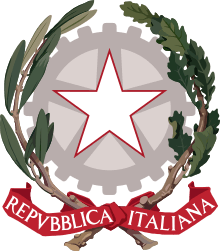Argentina–Italy relations
Argentina–Italy relations refers to the current and historical relations between Argentina and Italy. Both nations enjoy friendly relations, the importance of which centers on the history of Italian migration to Argentina. Argentines of full or partial Italian ancestry number approximately 30 million, or 62% of the country's total population.[1] Both nations are members of the G20 and the United Nations.
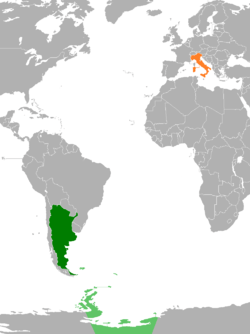 | |
Argentina |
Italy |
|---|---|
History
In 1816, Argentina declared its independence from Spain. At the same time, Italy was made up of separate independent Italian states. In May 1836, the Kingdom of Sardinia recognized and established diplomatic relations with Argentina, the first Italian state to do so.[2] In 1842, Italian General (and future unifier of Italy) Giuseppe Garibaldi, fought for Uruguayan rebels during the Uruguayan Civil War against the Argentine Confederation and Uruguayan Nationalist Party.[3]
In 1850, Sardinian King (and future King of a united Italy), Victor Emmanuel II, appointed an ambassador to Argentina.[2] In 1855, Argentina and Italy signed a Treaty of Friendship, Commerce and Navigation.[4] In 1924, Italy upgraded its diplomatic legation in Buenos Aires to an embassy.[4] That same year, Italian Prince Umberto of Piedmont (future King Umberto II) visited Argentina.[5] The Prince's main visit to Argentina (and other South American nations) was part of a political plan of fascism to link the Italian people living outside of Italy with their mother country.[5]
During World War II, Argentina remained neutral throughout most of the war and at the time, Argentine President Juan Perón was an admirer of Italian Prime Minister Benito Mussolini.[6] In 1944, due to international pressure, Argentina officially declared war on Germany and Japan as by that time, Italy had already surrendered to the Allies in September 1943. Soon afterwards, Argentina donated wheat to a defeated Italy.[7] In June 1947, Eva Perón paid an official visit to Italy during her Rainbow Tour of Europe.[8]
During the Argentine Dirty War from 1974-1983, eight Italian citizens went "missing" in Argentina.[9] In May 2007, Italy sentenced in absentia life sentences to five ex-navy Argentine officers for the murder of three of the eight Italians that went missing during the war.[10][11] In 1982, during the Falklands War between Argentina and the United Kingdom, Italy supported diplomatically the United Kingdom during the war, however, remained neutral in the fighting.[12]
High-level visits


High-level visits from Argentina to Italy
- President Arturo Frondizi (1960)
- President Arturo Umberto Illia (1965)
- President Isabel Martínez de Perón (1974)
- President Raúl Alfonsín (1987)
- President Carlos Menem (1997)
- President Fernando de la Rúa (2001)
- President Cristina Fernández de Kirchner (2009, 2011, 2013, 2014, 2015)
- President Mauricio Macri (2016)
- President Alberto Fernández (2020)
High-level visits from Italy to Argentina
- Prince Umberto (1924)
- President Giovanni Gronchi (1961)
- President Giuseppe Saragat (1965)
- Prime Minister Bettino Craxi (1983)
- President Sandro Pertini (1985)
- President Oscar Luigi Scalfaro (1995)
- President Carlo Azeglio Ciampi (2001)
- Prime Minister Romano Prodi (2007)
- Prime Minister Matteo Renzi (2016)
- President Sergio Mattarella (2017)
- Prime Minister Giuseppe Conte (2018)
Migration
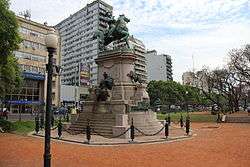
Between 1870–1960, over 2 million Italian nationals immigrated to Argentina.[1] Most Italians left Italy due to poverty and wars. In 2011, over 30 million Argentine citizens (approx. 62% of the population) claim Italian ancestry.[1] Italian culture has penetrated Argentine society in food and language as Argentine Spanish is heavily influenced by Italian. Several Argentine politicians, sports figures, actors, models and literary authors, among others (including the current Catholic Pope), are of Italian descent. Argentina hosts the second biggest Italian diaspora community in the world after Brazil.[13] In 1973, Argentina and Italy signed an Agreement on dual citizenship.[14]
The Argentine community in Italy totals 11,200 members; however, many Argentine citizens have dual citizenship with Italy and therefore the Argentine community in Italy may be greater.
Air transportation
There are direct flights between Argentina and Italy through the following airlines: Aerolíneas Argentinas and Alitalia.
Trade
In 2017, trade between Argentina and Italy totaled US$2.7 billion dollars.[15] Argentina's main exports to Italy include: wheat, soya beans, frozen crustacean, pears and beef. Italy's main exports to Argentina include: steam turbines, steel rails, machinery and medicine.[15] Italian car makers such as Ferrari, Fiat and Lamborghini have a presence in Argentina, as well as Italian fashion and food products. Joint Argentine-Italian steel company, Techint, is headquartered in both nations and operates in several countries globally. In 2000, member nations of Mercosur (which includes Argentina) and the European Union (which includes Italy) began negotiations on a free trade agreement.[16]
Resident diplomatic missions
- Argentina has an embassy in Rome and a consulate-general in Milan.[17]
- Italy has an embassy in Buenos Aires and consulates-general in Bahía Blanca, Córdoba, La Plata and Rosario and consulates in Mar del Plata and Mendoza.[18]
 Embassy of Argentina in Rome
Embassy of Argentina in Rome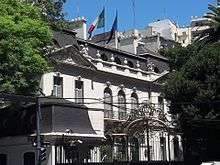 Embassy of Italy in Buenos Aires
Embassy of Italy in Buenos Aires Consulate-General of Italy in Buenos Aires
Consulate-General of Italy in Buenos Aires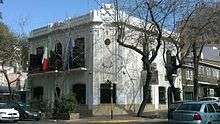 Consulate of Italy in Mendoza
Consulate of Italy in Mendoza
See also
References
- Historias de inmigrantes italianos en Argentina (in Spanish)
- Incidente Con Italia Por No Reconocer la Independencia de Argentina (in Spanish)
- Giuseppe Garibaldi: Exile in South America
- Relations between Italy and Argentina (in Italian)
- Umberto II, re d'Italia (King of Italy)
- Argentine Politics: As Confused as the Country
- Italia y Argentina 1943-1955: política, emigración e información periodística (in Spanish)
- “La gira del arco iris” (in Spanish)
- Trial of Argentina's 'Dirty War' soldiers to open in Italy
- Italy gives "Dirty War" Argentines life sentences
- Disappeared, but not forgotten
- Las claves del conflicto entre Gran Bretaña y Argentina por las Malvinas (in Spanish)
- Italian Nel Mondo (in Italian)
- Perfil Migratorio de Argentina (in Spanish)
- OEC: Argentina
- European Commission: Mercosur
- Embassy of Argentina in Rome (in Spanish)
- Embassy of Italy in Buenos Aires (in Italian and Spanish)

